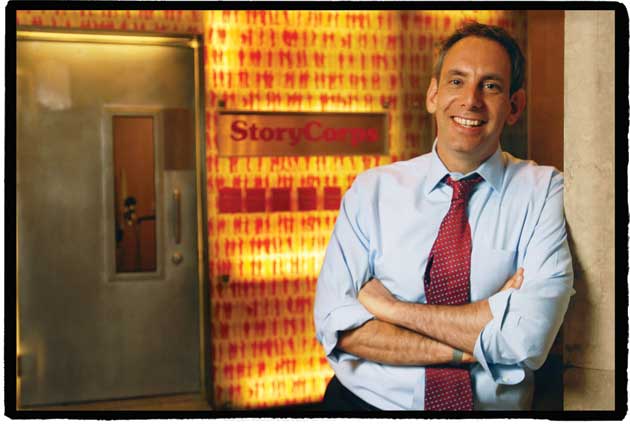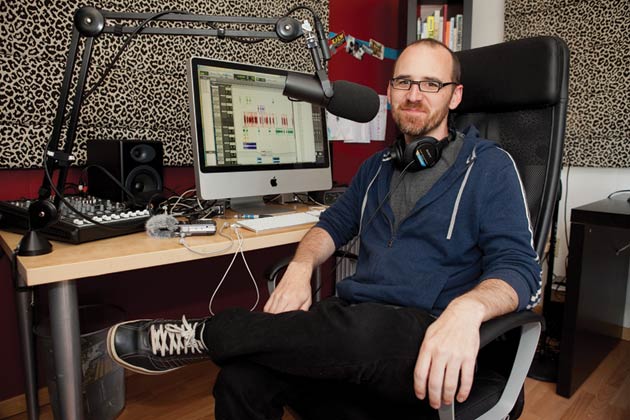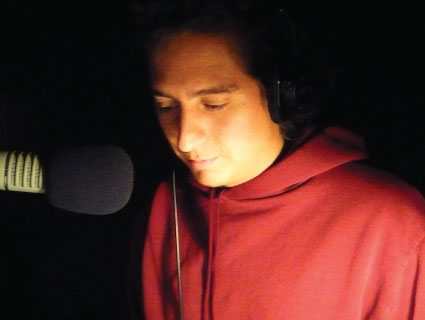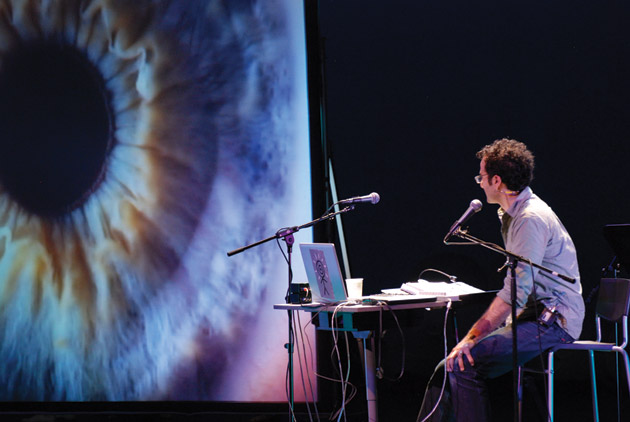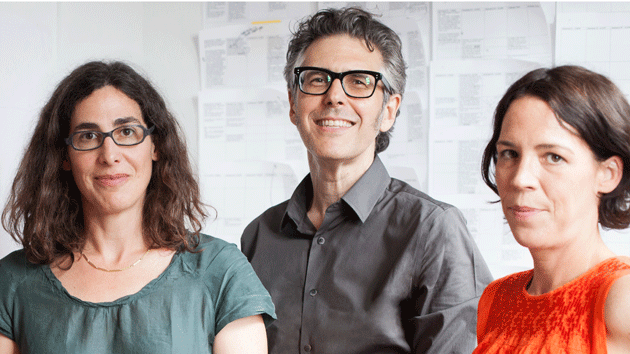
Coproducers Sarah Koenig (left) and Julie Snyder with "This American Life" host Ira Glass.Meredith Heuer
Sarah Koenig and Julie Snyder, producers for the popular radio show This American Life, are about to launch their latest project, a weekly podcast called Serial, hosted by Koenig. Here’s the gist: Rather than having short stories on a theme, like TAL, Serial draws out a single story for an entire season. As This American Life host Ira Glass puts it, “We want to give you the same experience you get from a great HBO or Netflix series, where you get caught up with the characters and the thing unfolds week after week, but with a true story, and no pictures. Like House of Cards, but you can enjoy it while you’re driving.”
The new podcast’s name refers to the story format—not a serial murderer. But the first season of Serial, premiering on October 3, explores the 1999 murder of a Baltimore high school senior, Hae Min Lee, for which her 17-year-old ex-boyfriend was convicted and sentenced to life in prison. I spoke with Koenig and Snyder about the origins of the project (which began as an experiment in Koenig’s basement), their deep-reporting process, and the ever-evolving ways in which we tell stories.
Mother Jones: Tell us more about the first season of Serial.
Koenig: We’re bringing you the story of not only the facts of the case, but the whole world of who they were and all their different relationships and cultural things that were happening. There are a lot of lingering questions about what happened, in big and small ways, and so we’re also trying to bring clarity to what happened to this girl.
Snyder: I’m afraid “bringing clarity to it” sounds…
Koenig: Boring?
Snyder: Yeah.
Koenig: It’s not! When you hear about a case—even if you’ve attended a trial—there’s a story presented which is a kind of agreed-upon narrative that each side brings. Maybe this is too obvious, but the thing that hooked me is realizing that the story they’re telling at trial is just one layer that’s just sitting on top of this whole super-interesting ocean that we don’t ever get to hear about. All this interesting stuff is tamped down by this clean narrative of, “Here’s what happened, and this must have happened this way and this must be what this relationship was.” And then you start piecing it apart.
MJ: Why did you choose this case in particular?
Koenig: Someone who knows the family of the guy who was convicted came to me to look into it, just: “Could somebody please, please, please take a look at this case, because we think all sorts of things went wrong in the trial.” I used to be a reporter at the Baltimore Sun, and the defense attorney on the case was someone that I had written about way back when. It didn’t have to do with this case, but other stuff: She had gotten in all sorts of trouble with the state regulatory board for lawyers and ended up getting disbarred. So they came to me because they had seen my name attached to these newspaper stories.
MJ: What was the catalyst for the concept of Serial?
Koenig: We just wanted to try something new! Julie and I worked together on other higher-adrenaline shows for the radio, like [This American Life‘s] “This Week” show, where we were trying to just do stories from the previous seven days. It was in the spirit of fun. We we haven’t heard of anybody else who’s tried this, so let’s try it!
Snyder: Telling a serialized story with cliffhangers and plot developments and stuff is not conducive to broadcast radio because it’s difficult for listeners and it’s difficult for stations to program. That’s the awesome thing with a podcast: We can do a story that unfolds over time. You can either go along—we’ll release them every Thursday—or people can binge once they’ve all been released.
MJ: Are you worried about keeping it interesting for 10 or 15 episodes?
Koenig: [Laughs.] Are you worried it will be bad? Is that what you’re asking, Lurie? No, it’s gonna be good! My worry is that I’ve gotten so up inside this thing that it’s like when you find something out about your family and you’re like, “You are not gonna believe: My Grandpa…” And nobody else cares but you. What’s good is that I have a check on me all the time. I’m relaying this info to other people and they’re still interested.
MJ: What storytelling devices have you learned at This American Life that you’re going to apply here?
Koenig: Everything. To get a little dorky about it, I think one of the things that makes This American Life really special—and maybe people that don’t do this work aren’t totally aware that this is happening—is the way that we structure stories with great care. What order we’re bringing you the information—that’s the art of it. And for this, where you’re really thinking over the course of a few months, it’s just a huge structural puzzle. That’s where I hope we’re good.
MJ: Who’s backing you?
Snyder: We’re essentially doing it out of This American Life‘s budget, just for the launch part. After that, we’ll have to start generating our own revenue. Everyone’s saying “It’s podcasting! It’s internet! Of course there’ll be money somewhere.” We’re not exactly sure yet.
MJ: Sarah, it sounds like you’ve really thrown yourself deep into this. Has your Serial reporting experience been different than it has been for other big projects?
Koenig: Yeah, I’ve now gotten to know a bunch of people in this story—some of them I feel like I know them know them. That doesn’t happen very often, and in some ways it’s great—it’s good for the story. Personally, sometimes it makes it harder. I’m struggling with separating my personal feelings about people from what they’re telling me and what the reporting is telling me to do. I have to check myself a lot to make sure, am I being fair to everybody? Obviously, in any story you’re trying to be careful, but if you don’t know somebody, you’re freer. They’re not friends, exactly, but I know them and they know me and now we’ve got that responsibility to each other. So that’s definitely different. I don’t know if the next season will be like that, but this story will. Because it’s about the basics: Love and death and justice and truth. All these big, big things.

